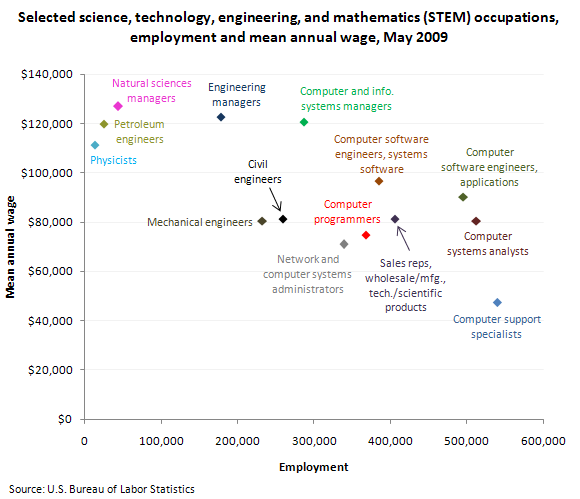June 15, 2011 (The Editor’s Desk is updated each business day.)
Science, technology, engineering, and mathematics (STEM) occupations, May 2009
In May 2009, STEM occupations—technical jobs in science, technology, engineering, and mathematics—represented about 6 percent of U.S. employment (nearly 8 million jobs).
The largest STEM occupations in May 2009 were related to computers. Computer support specialists, computer systems analysts, and computer software engineers (applications) each had employment of approximately 500,000. The largest STEM occupation that was not specifically computer related was sales representatives, wholesale and manufacturing, technical and scientific products, with employment of about 400,000.

[Chart data]
Overall in May 2009, STEM occupations were high-paying occupations. The mean annual wage for all STEM occupations was $77,880, and only 4 of the 97 STEM occupations had mean annual wages below the U.S. average of $43,460.
The highest-paying STEM occupations in May 2009 had mean annual wages of $100,000 or more, and included all of the managerial STEM occupations, petroleum engineers, and physicists. Natural science managers was the highest-paying STEM occupation with a mean annual wage of $127,000.
These data are from the Occupational Employment Statistics program. To learn more, see "Science, technology, engineering, and mathematics (STEM) occupations: a visual essay" (PDF), by Ben Cover, John I. Jones, and Audrey Watson in the May 2011 issue of the Monthly Labor Review.
Related TED articles
Earnings and wages |
Employment |
Industry |
Occupations |
Technology
Of interest
Spotlight on Statistics: National Hispanic Heritage Month
In this Spotlight, we take a look at the Hispanic labor force—including labor force participation, employment and unemployment, educational attainment, geographic location, country of birth, earnings, consumer expenditures, time use, workplace injuries, and employment projections.
.
Read more »
